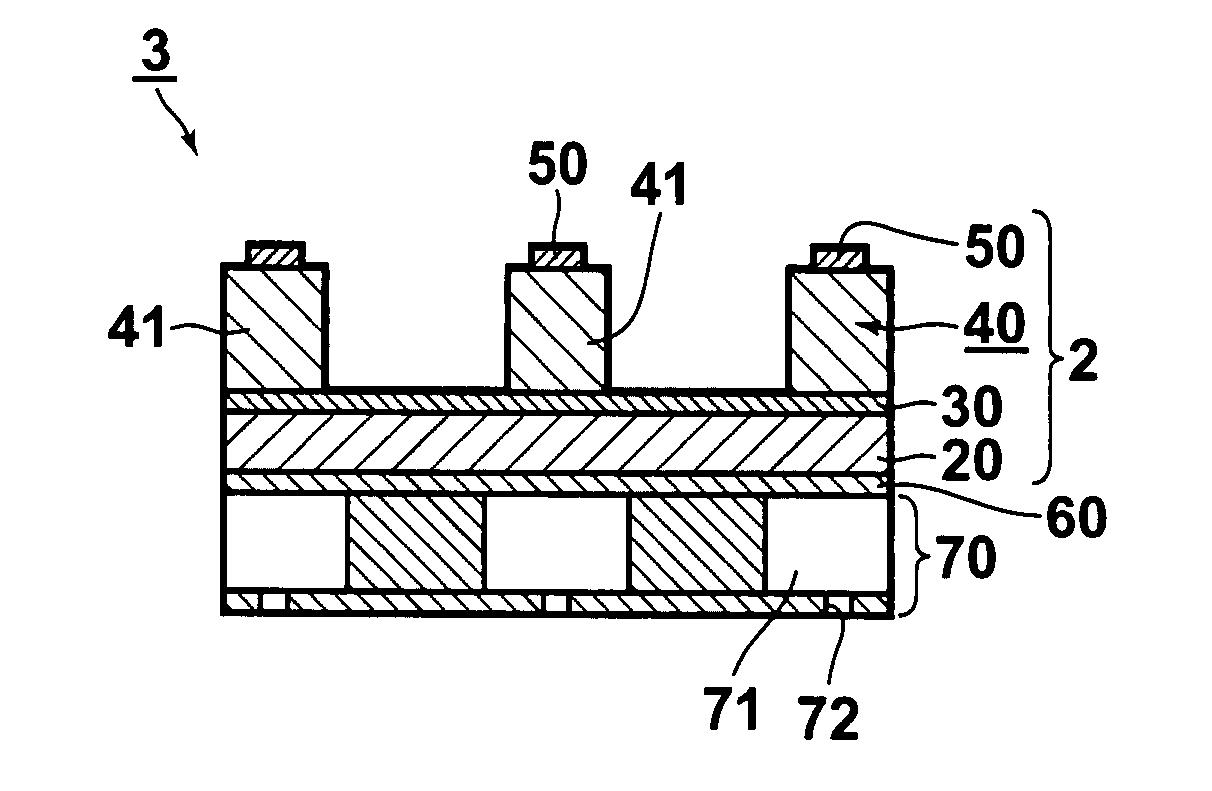Process for forming a film, piezoelectric film, piezoelectric device, and liquid discharge apparatus
- Summary
- Abstract
- Description
- Claims
- Application Information
AI Technical Summary
Benefits of technology
Problems solved by technology
Method used
Image
Examples
example 1
[0145]A piezoelectric film containing PZT or Nb-doped PZT was formed by use of the sputtering apparatus as illustrated in FIG. 1, under the conditions of a vacuum degree of 0.5 Pa and in an Ar / O2 mixed atmosphere (O2 volume fraction: 2.5%), by use of a target of Pb1.3Zr0.52Ti0.48O3 or Pb1.3Zr0.43Ti0.44Nb0.13O3. The Nb-doped PZT will hereinbelow be referred to as Nb-PZT.
[0146]As a base plate for film formation, an electrode-fitted base plate, in which a 30 μm-thick Ti close contact layer and a 150 nm-thick Pt bottom electrode had been overlaid in this order on an Si wafer, was prepared. The base plate / target distance was set at 60 mm.
[0147]The base plate was set in the floating state, a ground wire was located at a position, which was spaced apart from the base plate and which was outside of a region between the target and the base plate, and the film formation was performed. At this time, the plasma potential Vs and the floating potential (the potential in the vicinity of the base p...
example 2
[0154]A ground wire was located in the vicinity of the base plate in order for the plasma state of the apparatus to be altered, and the film formation was thus performed. At this time, as in Example 1, the plasma potential Vs and the floating potential Vf were measured. It was found that Vs−Vf=approximately 42V. Under the plasma conditions described above, the PZT film formation was performed with the film formation temperature Ts being set at various difference values within the range of 380° C. to 500° C. As for the obtained films, the XRD measurement was performed. FIG. 8 illustrates the XRD patterns of the principal films.
[0155]As illustrated in FIG. 8, under the conditions of the difference Vs−Vf (V)=approximately 42, the perovskite crystal having good crystal orientational characteristics was obtained at the film formation temperature Ts=420° C. Therefore, the film formation temperature Ts 420° C. was judged as being “”. At the film formation temperature Ts of at most 400° C....
example 3
[0157]The difference Vs−Vf (V) was altered through alteration of the position of the ground wire, and the film formation of the PZT film or the Nb-PZT film were performed. Also, the evaluation was made in the same manner as that in Example 2. With respect to each of the conditions of the difference Vs−Vf (V)=approximately 22, approximately 32, approximately 45, and approximately 50, the film formation temperature Ts was set at various different values, and the film formation was performed. In Examples 1, 2, and 3, the samples having been formed under the film formation conditions of the film formation temperature Ts=525° C. and the difference Vs−Vf (V)=approximately 12, approximately 32, and approximately 45 were the Nb-PZT films. The other samples were the PZT films.
[0158]FIG. 10 shows an example of the sample, which was associated with the XRD measurement results judged as being “×”. FIG. 10 illustrates the XRD pattern of the Nb-PZT film, which was formed under the conditions of t...
PUM
| Property | Measurement | Unit |
|---|---|---|
| Dielectric polarization enthalpy | aaaaa | aaaaa |
| Metallic bond | aaaaa | aaaaa |
| Piezoelectricity | aaaaa | aaaaa |
Abstract
Description
Claims
Application Information
 Login to View More
Login to View More - R&D
- Intellectual Property
- Life Sciences
- Materials
- Tech Scout
- Unparalleled Data Quality
- Higher Quality Content
- 60% Fewer Hallucinations
Browse by: Latest US Patents, China's latest patents, Technical Efficacy Thesaurus, Application Domain, Technology Topic, Popular Technical Reports.
© 2025 PatSnap. All rights reserved.Legal|Privacy policy|Modern Slavery Act Transparency Statement|Sitemap|About US| Contact US: help@patsnap.com



